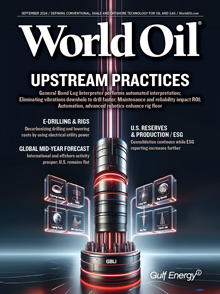Issue: September 2024
SPECIAL FOCUS: UPSTREAM PRACTICES
Electrification has proven to be effective in lowering costs and the carbon footprint of drilling operations. This article provides technical analysis of highline (grid) power utilization on rigs through the lens of an innovative technology that connects a rig to a power grid, reducing Scope One emissions to nearly zero.
New equipment automation advancements remove personnel from the red zone, improving safety, consistency, and efficiency.
By looking at inter-related metrics and how they impact the bottom line, experts can help deliver an improvement in maintenance strategies that may have traditionally been done using an “open and inspect process” on field operations and equipment—both of which are labor-intensive and higher-risk.
Operators are under great pressure to increase operational efficiencies, and drilling faster is key. However, pushing drilling equipment harder can be risky, as expensive components can be damaged by vibrations. Mitigating drilling dysfunctions caused by near-bit vibrations is crucial to increasing weight on bit (WOB), which leads to gains in ROP without compromising the drill bit or damaging the BHA.
The General Bond Log Interpreter (GBLI) is capable of interfacing with all cement bond logging tools and performing automated interpretation at >90% accuracy.
GLOBAL MID-YEAR FORECAST
As exploration and development activity increased in 2023, so did capital expenditures and mergers and acquisitions. Oil and gas companies have continued to increase their voluntary ESG disclosures.
After a year of upstream growth and success in 2023, operators are reducing costs, rig activity and drilling time in an effort to boost domestic energy security while returning cash to shareholders.
Optimism is slowly returning to the Canadian oil and gas sector, as global economic forces finally appear to be outpacing the misguided climate policies of the nation’s beleaguered federal government.
International activity is maintaining leisurely growth, while the U.S. continues to lag. Global oil production was up slightly in 2023, with stronger gains in the Americas. Offshore activity is buoyed by continued success in areas like Guyana, Suriname and Namibia.
COLUMNS
Based on the numbers our forecast, along with some anecdotal evidence from talking to industry professionals, I think it’s fair to say that the upstream industry is maintaining the status quo for the remainder of 2024, with great enthusiasm building for 2025.
What have we learned in exploration from working, not just to find commercial hydrocarbons, but also to understand fluid dynamics among fossil fuels, waters and other gases? Apparently, a lot.
Continuing with the story from in prior columns, we’re looking at U.S. drilling activity to see how drilling performance has changed over the last few years and what it might say about how we can advance drilling even further.
There has been significant emphasis on methane by the EPA lately. Simultaneously, there are many groups filing applications asking for the Supreme Court to intervene and stop some of these new rules. This adds a new level of complexity to the issue of measuring, monitoring, quantifying and reporting of methane emissions. So, let’s talk about some of this complexity.
Oil prices dipped in August—true to previous predictions by the EIA—and compiled futures prices are expected to continue to drop into September.



